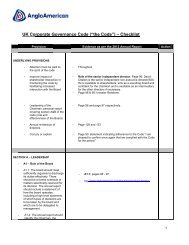pdf [ 1.5MB ] - Anglo American
pdf [ 1.5MB ] - Anglo American
pdf [ 1.5MB ] - Anglo American
You also want an ePaper? Increase the reach of your titles
YUMPU automatically turns print PDFs into web optimized ePapers that Google loves.
Scaw Metals Group Sustainable Development Report 2005 27<br />
Summary of Group Health Targets and Performance<br />
Targets 2005 Performance 2005 Targets 2006<br />
Set targets for medical surveillance to ensure all employees<br />
are examined at correct intervals.<br />
All remaining cases of occupational diseases to be identified<br />
and submitted for compensation.<br />
Ensure all noise zones re-identified as per country standard,<br />
demarcated and suitable hearing protection devices issued.<br />
Health risk assessment carried out on all hazardous<br />
chemicals, Material Safety Data Sheets obtained and<br />
medical surveillance carried out where appropriate.<br />
90% of medical surveillance achieved.<br />
Majority of occupational diseases now identified and<br />
submitted for compensation.<br />
All noise zones identified, demarcated and suitable<br />
hearing protection issued.<br />
Initiated but still ongoing.<br />
Ensure medical surveillance targets continue to be met.<br />
Perform risk assessments and where appropriate initiate<br />
medical surveillance for hand arm vibration (HAV).<br />
Monitored on an ongoing basis.<br />
Ongoing.<br />
Milestones and Achievements<br />
A health profile of the workforce has been determined and<br />
the majority of occupational diseases from previous exposure<br />
have been processed and submitted for compensation.<br />
Future cases of occupational diseases will be as a result<br />
of a failure of current measures instituted to prevent them.<br />
Occupational health aspects are not as visible as accidents,<br />
which are immediate and often dramatic, while occupational<br />
diseases on average take many years to develop. Thus<br />
employees may not feel as inclined to wear personal<br />
protective equipment (PPE) for disease prevention as they<br />
might do for accident prevention. However, every effort is<br />
being made to substitute, eliminate and reduce hazards<br />
where possible.<br />
A computerised primary health care system (Meddocs) has<br />
been implemented in the group’s South African clinics,<br />
which will allow for the collection of better information on<br />
employee health status.<br />
Review of 2005<br />
There has been an extensive investigation into manganese<br />
exposure over the past year. Exposure to manganese<br />
fumes or dust occurs during melting where manganese is<br />
added to the furnace to produce manganese steel. Exposure<br />
also occurs during fettling, gouging or welding when a<br />
casting is being dressed, as well as during gas cutting of<br />
manganese steel into smaller pieces to enable it to be<br />
remelted in the furnaces.<br />
Repeated occupational hygiene testing showed manganese<br />
in-air-levels was very low. However, some random blood<br />
manganese sampling did show levels to be at the upper<br />
level for non-exposed individuals, indicating some level of<br />
exposure and absorption. The correlation between blood/<br />
urine manganese levels and susceptibility to manganese<br />
poisoning or manganism is poor and there is no direct<br />
exposure relationship.<br />
As a result, the decision was taken to start medical<br />
surveillance on manganese exposed individuals. This will<br />
take the form of an individual manganese questionnaire<br />
and neurological examination. Biological monitoring will be<br />
done on a group basis on selected individuals to test for<br />
evidence of exposure and to assess whether intervention<br />
programmes have been successful, for example better<br />
local extraction. Concurrently efforts are being made to<br />
remove fumes and dust where possible in order to reduce<br />
the airborne levels even further.


![pdf [ 1.5MB ] - Anglo American](https://img.yumpu.com/34179502/29/500x640/pdf-15mb-anglo-american.jpg)

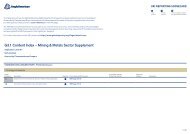
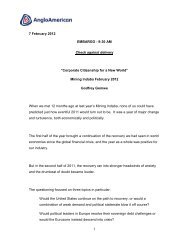


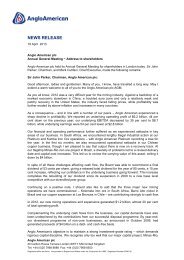
![English PDF [ 189KB ] - Anglo American](https://img.yumpu.com/50470814/1/184x260/english-pdf-189kb-anglo-american.jpg?quality=85)


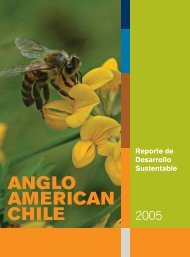

![pdf [ 595KB ] - Anglo American](https://img.yumpu.com/49420483/1/184x260/pdf-595kb-anglo-american.jpg?quality=85)
![pdf [ 1.1MB ] - Anglo American](https://img.yumpu.com/49057963/1/190x240/pdf-11mb-anglo-american.jpg?quality=85)
